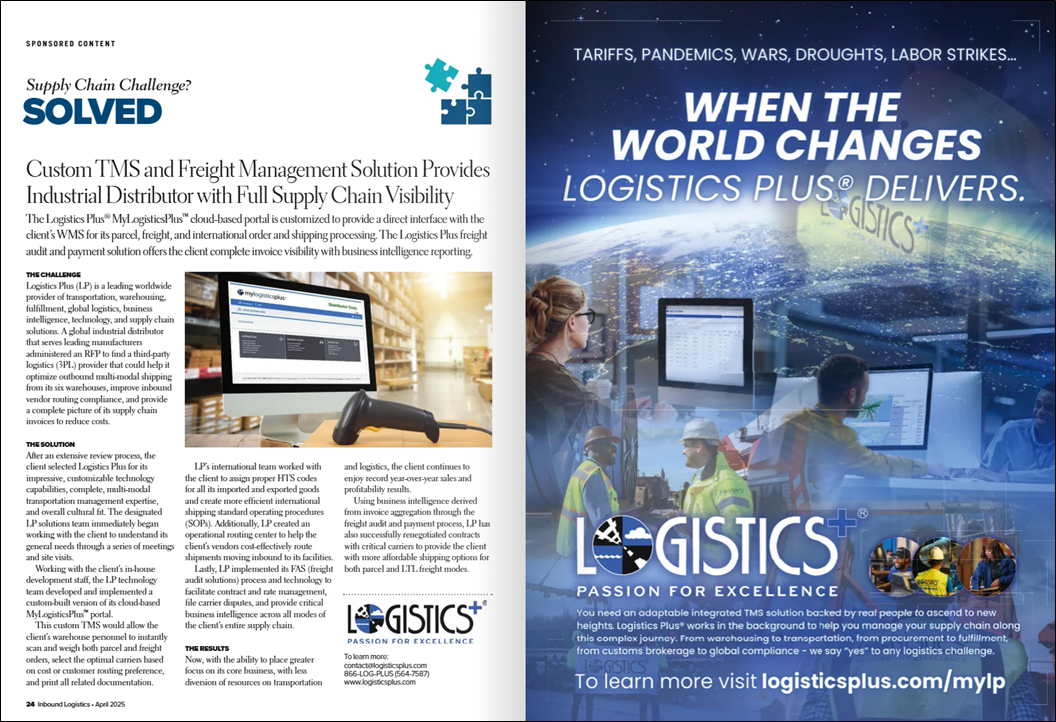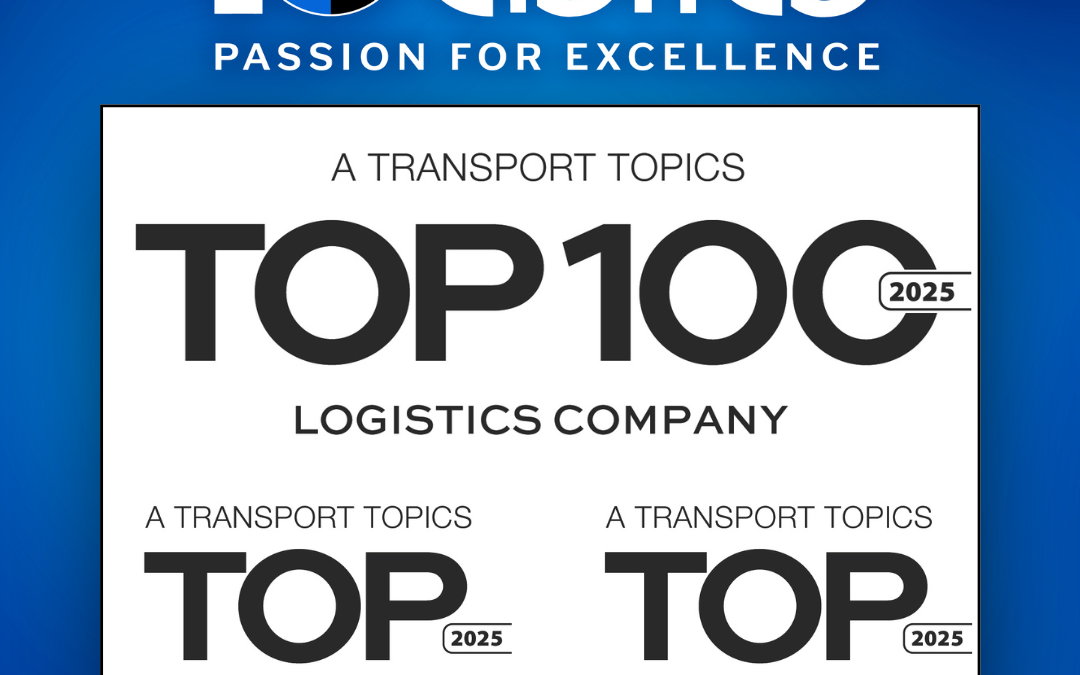
by Scott Frederick | Apr 24, 2025 | Global Logistics Alerts

Courier firm DHL to suspend global shipments of more than $800 to US due to new customs rules
DHL, the international courier firm, will temporarily pause shipments to the U.S. for items with a declared value of more than $800, the company announced in a notice. The announcement said that, starting Monday, the company will stop collecting and shipping orders from businesses abroad to private individual customers in the U.S. if the declared custom value exceeds $800.
Read More:
https://www.dhl.com/us-en/home/important-information/2025/shipments-to-the-united-states-with-a-customs-value-exceeding-usd-800.html
https://thehill.com/business/5258076-dhl-temporarily-pauses-us-shipments-over-800/?tbref=hp


by Scott Frederick | Apr 24, 2025 | News

Logistics Plus is Named a 2025 Top 100 Logistics & Supply Chain Technology Provider
It’s the third straight year that Logistics Plus has been named to the annual Inbound Logistics magazine list.
 ERIE, PA (April 24, 2025) – Logistics Plus, Inc. (LP), a global leader in transportation, logistics, and unique supply chain solutions, is proud to announce that it has been named a Top 100 Logistics & Supply Chain Technology Provider for 2025 by Inbound Logistics magazine. The list, curated annually by the editors of Inbound Logistics, recognizes 100 logistics companies whose solutions are central to solving transportation, logistics, and supply chain challenges and whose customer successes are well-documented.
ERIE, PA (April 24, 2025) – Logistics Plus, Inc. (LP), a global leader in transportation, logistics, and unique supply chain solutions, is proud to announce that it has been named a Top 100 Logistics & Supply Chain Technology Provider for 2025 by Inbound Logistics magazine. The list, curated annually by the editors of Inbound Logistics, recognizes 100 logistics companies whose solutions are central to solving transportation, logistics, and supply chain challenges and whose customer successes are well-documented.
“The editorial selection committee had their work cut out for them, especially with all the new entrants and solutions in the market, ultimately selecting only 100 technology solutions leaders from the 400+ candidates who submitted their credentials,” said Felecia Stratton, Editor for Inbound Logistics. “Our Top 100 list provides crucial decision support for our audience, all the more important this year considering the need and the innovations coming online.”
The Top 100 Logistics IT Providers list appears in all the April 2025 magazine editions and will be posted online and promoted across the various Inbound Logistics media platforms. View the list online at https://www.inboundlogistics.com/articles/top-100-logistics-it-providers/ or read the April 2025 digital edition of Inbound Logistics at https://www.inboundlogistics.com/digital-editions/.
A Logistics Plus TMS case study and advertisement are also showcased in the magazine.

About Inbound Logistics
Inbound Logistics (IL) is the pioneering magazine empowering demand-driven enterprises. IL’s educational mission is to guide businesses to efficiently manage logistics, reduce and speed inventory, and neutralize transportation cost increases by aligning supply to demand and adjusting enterprise functions to support that paradigm shift. More information about demand-driven enterprise practices is available at inboundlogistics.com.
About Logistics Plus, Inc.
Logistics Plus, Inc. (LP) is a 21st Century Logistics Company™ and a leading worldwide provider of transportation, warehousing, fulfillment, global logistics, business intelligence, technology, and unique supply chain solutions. When the world changes, Logistics Plus® delivers. Founded in 1996, today LP has annual global sales of over $600M with more than 1,200 employees located in 50+ countries worldwide. LP is recognized as one of the fastest-growing privately-owned logistics companies, a top 3PL provider, a top 100 logistics company, a top freight brokerage and warehousing provider, and a great place to work. With a Passion For Excellence™, its employees put the PLUS in LOGISTICS by doing the big things properly, plus the countless little things that together ensure complete customer satisfaction and success. Learn more at logisticsplus.com or download our media & press kit.




by Scott Frederick | Apr 22, 2025 | Global Logistics Alerts

Notice of Action and Proposed Action in Section 301 Investigation of China’s Targeting the Maritime, Logistics, and Shipbuilding Sectors for Dominance, Request for Comments
The Trump Administration issued an order that could dramatically change global distribution patterns, or create some interesting distribution challenges as companies work to avoid fees. Read notice here:
https://ustr.gov/sites/default/files/files/Press/Releases/2025/301%20Ships%20-%20Action%20FRN%204-17.pdf
The new order spells out the following (from Armada Corporate Intelligence):
1. Fees for Chinese-Owned and Operated Ships
• Grace Period: $0 for the first 180 days (until October 14, 2025).
• Phase 1 (October 14, 2025 – April 17, 2026):
• Fee: $50 per net ton per U.S. voyage (applied up to 5 times annually per vessel).
• Per Container Equivalent: ~$120 per container unloaded.
• Annual Increases:
• 2026–2027: $80 per net ton ($190 per container).
• 2027–2028: $110 per net ton ($220 per container).
• By April 17, 2028: $140 per net ton ($250 per container).
2. Fees for Chinese-Built Ships (Owned by Non-Chinese Entities)
• Grace Period: $0 for the first 180 days (until October 14, 2025).
• Phase 1 (October 14, 2025 – April 17, 2026):
• Fee: $18 per net ton per voyage (applied up to 5 times annually per vessel).
• Per Container Equivalent: ~$45 per container unloaded
• Annual Increases:
• 2026–2027: $23 per net ton ($170 per container).
• 2027–2028: $28 per net ton ($220 per container).
• By April 17, 2028: $33 per net ton ($250 per container).
3. Car Carrier Fees (Foreign-Built, Non-U.S.)
• Grace Period: $0 until October 14, 2025.
• Post-Grace Period: $150 per car equivalent (CEU) unit.
4. Exemptions
• Empty vessels arriving to load U.S. exports (e.g., coal, grain).
• Ships with capacity ≤4,000 TEU (containers) or ≤55,000 deadweight tons (bulk carriers).
• Vessels operating in the Great Lakes or traveling <2,000 nautical miles to U.S. ports.
• U.S.-flagged carriers in short-sea shipping (e.g., Hawaii routes).
5. LNG Carrier Restrictions (Phase 2)
• Begins in 2028: Gradual restrictions on foreign-built LNG carriers transporting U.S. LNG.
• Full restrictions by 2047: Only U.S.-built LNG carriers allowed for U.S. exports.
6. Waivers for U.S.-Built Ship Orders
• Operators can avoid fees if they order U.S.-built ships of equivalent capacity within 3 years.
Impact on Per-Container Costs
• By 2028, fees could add $250 per container for Chinese-owned ships and $250 per container for Chinese-built ships.
• For context, a typical 10,000-TEU container ship could face $2.5 million in fees per voyage under the 2028 rates.
Industry Implications: Just based on early assessments, there are some early impacts that are worth considering. For most product types, the extra container fee will be spread out and will likely not be felt. It will be more of a fee-based revenue generator for the US general fund. But for some product categories, it could be difficult for them to absorb some of the fees once the order is fully mature (2028).
Some early thinking on what could happen:
• Obviously, higher shipping costs: Likely passed to U.S. importers/consumers, exacerbating inflation.
• Port congestion: Smaller ports may lose traffic as carriers consolidate at major hubs (e.g., Los Angeles, New York).
• Trade diversion: Chinese goods may reroute through Europe or other regions to avoid fees.


by Scott Frederick | Apr 21, 2025 | Global Logistics Alerts

Global Trade Resources at a Glance from Armada Corporate Intelligence
Our good friends and partners at Armada Corporate Intelligence have put together a helpful list of resources on tariffs. At the Federal level, here are the resources directly connected to the White House. They break down tariff decisions into Annex’s. Annex 1, 2, and 3 are listed below with a link to that source (which is reportedly updated constantly).
Annex 1: Targeted Retaliation: pressures countries with asymmetric trade barriers (e.g., Vietnam’s 90% tariffs on U.S. goods).
Annex 2: Economic Security: protects sectors vital to U.S. infrastructure and defense (e.g., semiconductors, energy). 37 pages – ~925 exclusions – In 2018-2019 it was 10,500+
Annex 3: Legal Precision: ensures CBP can enforce layered tariffs (e.g., China’s 34% reciprocal + 20% IEEPA + 7.5–25% Section 301).
Reed Smith also puts out a good resource in its Trump 2.0 Tariff Tracker:
https://www.tradecomplianceresourcehub.com/2025/04/16/trump-2-0-tariff-tracker/
Global Logistics Connections also releases a pretty good timeline of changes to tariffs.
https://glcinc.com/2025/04/in-real-time-todays-top-tariff-headlines/
And this one from the Atlantic Council is also really interesting.
https://www.atlanticcouncil.org/programs/geoeconomics-center/trump-tariff-tracker/
Hopefully, you find these resources helpful.


by Scott Frederick | Apr 15, 2025 | News

Logistics Plus Once Again Ranks Among Transport Topics 2025 Top 100 North American Logistics Companies
Logistics Plus was also named a Top Dry Storage Warehousing Firm and a Top Freight Brokerage Firm again.
 ERIE, PA (April 15, 2025) – Logistics Plus, Inc. (LP), a global leader in transportation, logistics, and unique supply chain solutions, is proud to announce that it has been named to the annual Transport Topics Top 100 list of North America’s largest logistics companies based on gross revenue for the most recent 12-month period. Logistics Plus moved up two positions in the rankings to the 80th spot. It’s the third straight year that Logistics Plus has been named to the list. Logistics Plus also ranked as the 32nd largest dry storage warehousing firm (up from 38th last year) and the 66th largest freight brokerage firm (same as last year).
ERIE, PA (April 15, 2025) – Logistics Plus, Inc. (LP), a global leader in transportation, logistics, and unique supply chain solutions, is proud to announce that it has been named to the annual Transport Topics Top 100 list of North America’s largest logistics companies based on gross revenue for the most recent 12-month period. Logistics Plus moved up two positions in the rankings to the 80th spot. It’s the third straight year that Logistics Plus has been named to the list. Logistics Plus also ranked as the 32nd largest dry storage warehousing firm (up from 38th last year) and the 66th largest freight brokerage firm (same as last year).
“In addition to enduring a stubbornly slow freight market recovery, the largest third-party logistics providers in North America are now navigating supply chain uncertainty stemming from tariffs and rapidly shifting trade policies,” said Seth Clevenger, managing editor of features and multimedia at Transport Topics. “Despite these challenges, the industry’s top 3PLs have been boosting freight efficiency and building more resilient supply chains in a changing world.”
“Our DNA is logistics,” said Jim Berlin, Founder and CEO of Logistics Plus. “As we have grown, today we have ten million feet of warehousing in North America and more globally, we do software development, we transport everything from pallets to rockets around the world. We say yes to any supply chain challenge, opening up new opportunities for our people and customers.”
To learn who made the list and read more about the issues facing logistics companies, visit Transport Topics at https://www.ttnews.com/logistics/rankings/2025.
Also, earlier this year, Logistics Plus was named to Newsweek’s Excellence 1000 Index, was certified as a Great Place to Work for an eighth year, and was recognized as a Top 100 Logistics & Supply Chain Technology Provider by Inbound Logistics magazine for a fourth year.
About Transport Topics
Since 1935, Transport Topics has been the news leader in trucking and freight transportation. When it comes to major issues, industry events, and new developments, TT journalists get the story first and get it right, keeping readers informed about all aspects of the trucking industry and helping them stay ready for what’s to come. Explore the latest at https://www.ttnews.com.
Logistics Plus Supply Chain Success Stories
About Logistics Plus, Inc.

Brief Audio Comment
Logistics Plus, Inc. (LP) is a 21st Century Logistics Company™ and a leading worldwide provider of transportation, warehousing, fulfillment, global logistics, business intelligence, technology, and unique supply chain solutions. When the world changes, Logistics Plus® delivers. Founded in 1996, today LP has annual global sales of over $600M with more than 1,200 employees located in 50+ countries worldwide. LP is recognized as one of the fastest-growing privately-owned logistics companies, a top 3PL provider, a top 100 logistics company, a top freight brokerage and warehousing provider, and a great place to work. With a Passion For Excellence™, its employees put the PLUS in LOGISTICS by doing the big things properly, plus the countless little things that together ensure complete customer satisfaction and success. Learn more at logisticsplus.com or download our media & press kit.














